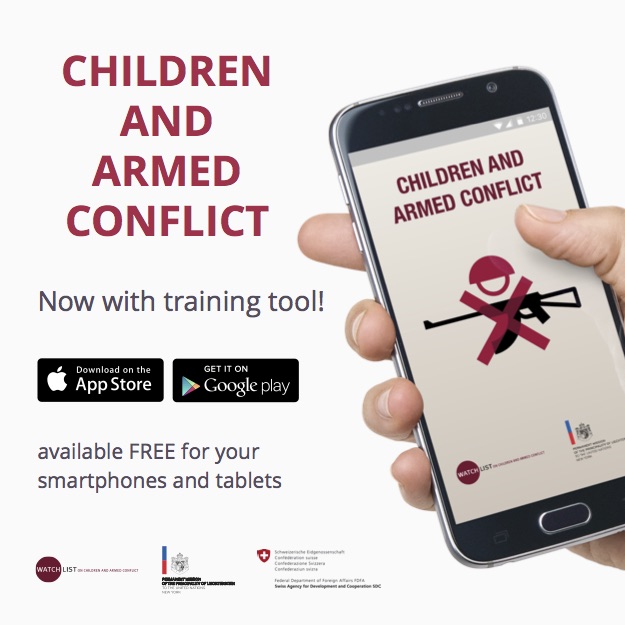In November, Watchlist traveled to Amman, Jordan, to participate in a technical consultation of experts on the implementation of the UN’s Children and Armed Conflict (CAAC) agenda in the Middle East and North Africa.
The first of its kind in the region, the consultation brought together child protection experts, including field-based UN staff, UN Regional Offices, the Office of the Special Representative of the Secretary-General for Children and Armed Conflict (OSRSG-CAAC), and representatives of international nongovernmental organizations (NGOs), to discuss implementation of the UN Monitoring and Reporting Mechanism (MRM) and monitoring of CAAC situations of concern. The meeting provided a unique opportunity for exchange among experts covering the country situations of Iraq, Israel/State of Palestine, Lebanon, Libya, Syria, and Yemen.
Watchlist was invited to speak about the role of NGOs in implementing the CAAC agenda, including the importance of their inclusion and active participation in the MRM. Security Council Resolution 1612 (2005) underlines that the MRM “must operate with the participation of and in cooperation with national governments and relevant United Nations and civil society actors, including at the country level” (para. 2(b)). Moreover, the MRM Guidelines state that international and local NGOs play “a central role in the MRM at all levels.” Watchlist further highlighted that NGOs often have a unique knowledge of the conflict, more mobility, and trust within communities, and they will remain present after the conflict ends. However, Watchlist noted that while the MRM is stronger when it includes the active participation of NGOs, the decision of whether and how to participate, including the level and type of engagement, should be determined by the NGOs themselves in each country context.
Watchlist also spoke in a session on child protection and peace processes, underscoring the necessity of incorporating inclusive and child protection-relevant language and provisions into peace agreements. Watchlist highlighted the “Checklist for Drafting Children and Armed Conflict Provisions in Ceasefire and Peace Agreements,” a tool developed by Watchlist in consultation with UN Member States and child protection and mediation experts in 2016 and now an official resource in the UN Peacemaker Database. The checklist provides recommendations to mediators and their teams to assist them in incorporating child protection language in peace accords. Today, a working draft of the checklist is available in English, Arabic, French, and Spanish, and is widely accessible via the UN’s website. The document is purposely considered to be a ‘working draft,’ that can and should be periodically reviewed, corrected, and expanded, in order to strengthen its usefulness for mediators and parties to conflict. Watchlist continues to highlight and promote use of the checklist, and is seeking new ways to mainstream and further strengthen the protection of children’s rights in peace processes.
The consultation provided an important space for UN child protection staff and those implementing the MRM, UN Regional Offices, and INGOs to have frank discussions on the challenges to their work in order to learn from one another, improve cooperation, and strengthen implementation of the MRM. Moreover, it was especially timely given current developments in the region and the anticipated publication of the Secretary-General’s country-specific CAAC reports from the region.
Most recently, in November the Secretary-General publicly released his second report on children and armed conflict in Syria. Covering a significant portion of the Syrian war, from November 2013 to June 2018, the Secretary-General concludes in the report that “parties to the conflict have exhibited a blatant disregard for the lives and fundamental rights of children.” During the reporting period, the UN verified 12,537 grave violations against children, just the tip of the iceberg according to Panos Moumtzis, the Regional Humanitarian Coordinator for the Syria Crisis. The report notes that the protracted and high-intensity nature of the conflict and severe access restrictions posed considerable challenges to the UN’s ability to verify incidents.
The report on Syria also found that the killing and maiming of children — the most prevalent of the six grave violations — was often a result of the use of indiscriminate or disproportionate weapons, such as barrel bombs or cluster munitions. The UN also verified the deaths by torture or summary execution of 152 children by firearm, knife, crucifixion, stoning, sword, or throwing from a high-rise building, most often during their abduction or deprivation of liberty. One in three children conscripted, enlisted, or used to participate actively in hostilities was below 15 years of age; schools and hospitals continued to be indiscriminately attacked, with more than 400 medical, education, and humanitarian personnel killed, injured or abducted, affecting entire education and health systems. Incidents of sexual violence against children remained highly underreported, but the 98 verified incidents included rape, gang rape, forced marriage to armed group fighters, and trafficking and sexual enslavement, attributed to the Islamic State of Iraq and the Levant (ISIL) and other non-State armed groups, Syrian Government forces, and pro-Government militias.
Watchlist commends the tireless, committed efforts of UN agencies and NGOs to monitor and report on child rights violations. Through these efforts, this report provides a systematically documented account of what has happened to the children of Syria.
For more on Watchlist’s work on Syria, including its latest recommendations for the UN Security Council and its Working Group on CAAC, please visit https://watchlist.org/countries/syria/.



